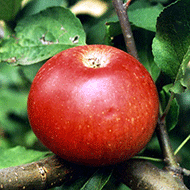Čačanska pozna
It derived from a cross of 'Starking' and 'Jonathan'. The hybridization was performed in 1959 and it was named and released in 1971. The breeders are prof. Dr. Petar Mišić and Dr. Milisav Gavrilović.
The tree is upright and strong, cylindrical. Belongs in a group of vigorous cultivars. The crown is wide, pyramidal. The branches are medium long, well covered with fruiting wood, with rather wide branch angles. The bark is grey, with pronounced white lenticels. The shoots are upright and sturdy, darker than scaffold branches, with medium-sized lenticels. Leaf and wood buds are medium sized, pointed and appressed. Fruit buds are large and pointed. The leaf is large, elliptical, with a rounded tip, widely serrated, dark and smooth, with a short petiole. The flower is medium-sized, white and regular. It is a diploid cultivar, with mid-late flowering time. It comes into bearing earlier and produces good crops if grafted on moderately vigorous rootstocks. It is not susceptible either to apple scab (Venturia inaequalis) or to apple powdery mildew (Podosphaera leucotricha).
The fruit is large (200g on average), roundish-flat (average length 66 mm and width 79 mm), slightly ribbed at the eye. The calyx is half-open to closed, set in medium deep and medium wide funnel, surrounded by slight ribs. The fruit skin is medium thick, tough, glossy and waxy. The ground color is green-yellow, blushed dark red on 80% of the fruit surface. The flesh is firm, pale yellow, medium acid, with pronounced aroma. It contains 11.5% total sugars and 0.79% total acids. The core is large, bulb-shaped, with an unbroken axis. The seeds are long, broadened in the middle, and pointed at the tip. The stalk is medium long, and cavity is medium deep and wide, slightly russetted.
It ripens in late September and early October. The fruits may be stored all through to late March.
By its economic and biological properties it is a winter cultivar of high fruit quality. Recommended for grafting on low-vigorous rootstocks as well as for growing on smaller areas.

 English
English Srpski
Srpski 